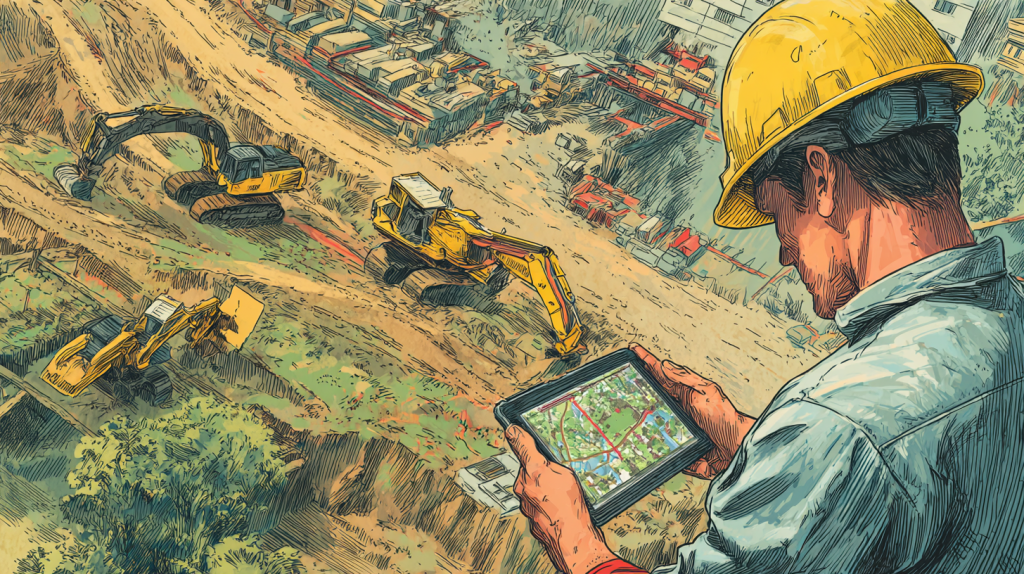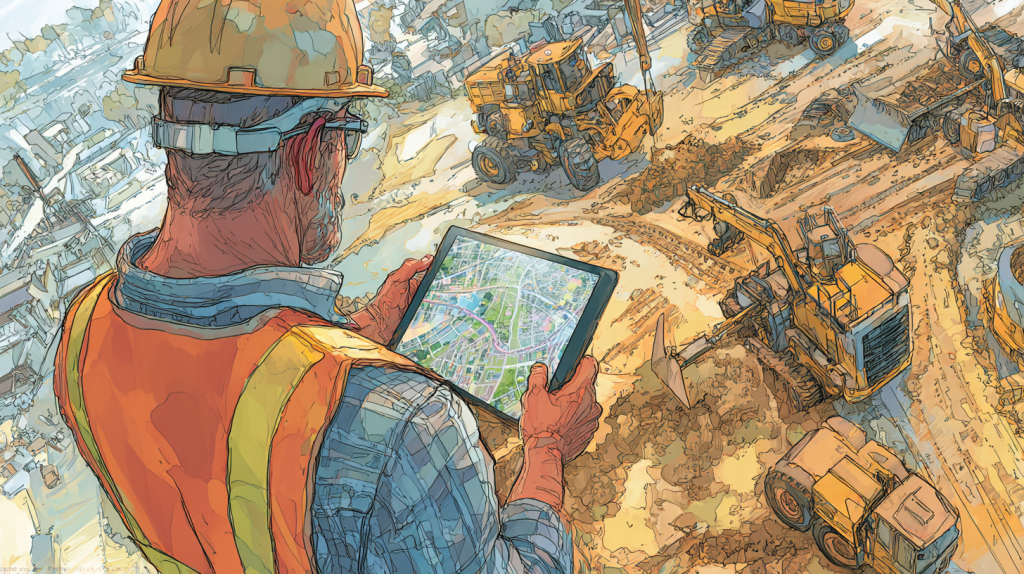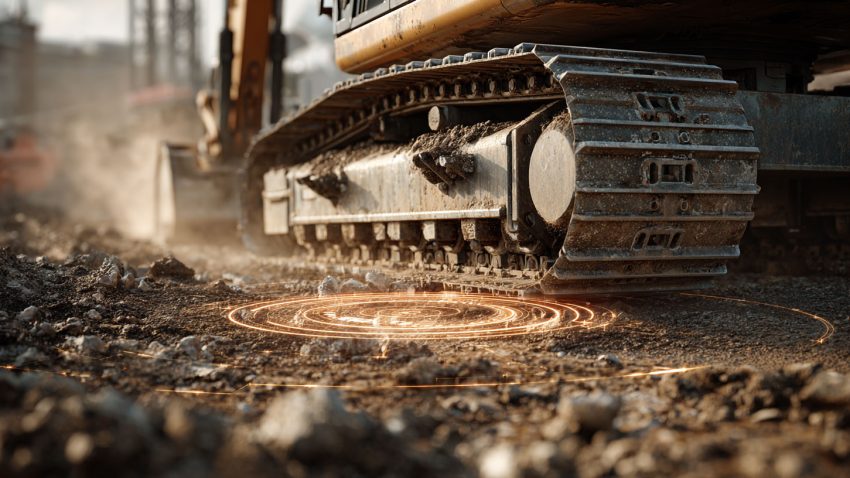What Is the Purpose of a Site Utilization Plan in Construction Projects?
Table of Contents:

What Is a Site Utilization Plan and Why Does It Matter in Construction Projects?
A Site Utilization Plan (SUP) is one of the most critical, yet often misunderstood, documents in construction project management. It is the master blueprint for how every square foot of a jobsite will be organized, accessed, and managed throughout the project lifecycle. From laydown areas and crane swing zones to pedestrian walkways and emergency routes, the SUP establishes the physical foundation for safety, efficiency, and coordination.
The primary purpose of a Site Utilization Plan is to optimize space and workflow—especially on crowded or complex sites where multiple trades, deliveries, and pieces of equipment compete for limited room. A well-designed SUP helps superintendents and project managers visualize the site layout before mobilization, anticipate potential conflicts, and plan logistics that minimize delays or hazards.
Unlike a project schedule, which dictates when tasks occur, the SUP focuses on where and how they take place. It’s both a safety document and an operational map, ensuring that materials, crews, and equipment move smoothly without interfering with one another.
In this article, we’ll explore why Site Utilization Plans are so essential, what they include, and how they evolve throughout a project. You’ll also learn how digital tools like StruxHub and GIS mapping are transforming how these plans are created, updated, and shared. Whether you’re an owner, superintendent, or contractor, understanding the purpose of a Site Utilization Plan can make the difference between a well-coordinated project and a chaotic jobsite.
Why Every Construction Project Needs a Site Utilization Plan
Every successful construction project starts with a plan—not just for scheduling or budgeting, but for how space itself will be used. A Site Utilization Plan provides that foundation, ensuring that the physical layout of the jobsite supports safe and efficient operations.
Without a SUP, even the most organized teams can experience confusion, traffic congestion, and safety hazards. Equipment may block access routes, materials pile up in unsafe zones, and deliveries interfere with ongoing work. The SUP prevents these issues by mapping out staging areas, routes, and clearances ahead of time, creating order from potential chaos.
For owners, the SUP also provides assurance that contractors are thinking strategically about safety and logistics. For superintendents, it’s a daily reference point for managing manpower, deliveries, and site sequencing.
Top Benefits
- Establishes a clear spatial strategy before construction begins.
- Prevents congestion, bottlenecks, and unsafe work conditions.
- Improves communication among all project stakeholders.
Best Practices
- Develop the SUP during preconstruction with input from field teams.
- Review and revise the plan as project phases change.
- Use color-coded layouts to distinguish between trades and zones.
Q&A Mini Section
Q: Who typically creates the Site Utilization Plan?
A: The general contractor or construction manager usually develops it during preconstruction in collaboration with engineers and field supervisors.
Q: How does a SUP differ from a Site Logistics Plan?
A: The SUP focuses on overall layout and strategy, while the logistics plan details daily operations and deliveries.
Q: When should the SUP be updated?
A: Updates should occur whenever major milestones are reached or when new structures, cranes, or temporary facilities are added.
A thoughtful SUP sets the tone for the entire project, ensuring that efficiency and safety are built into the site from day one.

What Information Should a Site Utilization Plan Include?
A strong Site Utilization Plan is more than just a drawing—it’s a visual coordination tool that combines safety, logistics, and operational strategy. At a minimum, the SUP should show major components like crane locations, laydown areas, access roads, storage zones, and pedestrian walkways.
Other essential elements include site boundaries, temporary structures, fencing, gates, signage, emergency routes, and utility connections. The plan should clearly identify restricted areas, waste management zones, and environmental protection measures such as silt fencing or drainage controls. For multi-phase projects, the SUP may include several versions—each corresponding to a specific stage of construction.
The goal is clarity. Every stakeholder, from delivery drivers to subcontractor foremen, should be able to understand the plan at a glance. Color coding, labeling, and layering by phase or trade help make the document intuitive and easy to follow.
Top Benefits
- Provides a comprehensive visual guide to site organization.
- Enhances safety by clearly marking restricted and hazard areas.
- Supports permitting and regulatory compliance documentation.
Best Practices
- Include scale references and north orientation for accuracy.
- Use distinct color coding for temporary vs. permanent elements.
- Verify accuracy through field walks before finalizing.
Q&A Mini Section
Q: Should the SUP include future work areas or only current ones?
A: It should include both current and planned zones to anticipate future space requirements and avoid rework.
Q: What tools are best for creating a SUP?
A: CAD, BIM, and GIS-based software are commonly used for accurate layering and easy updating.
Q: Is the SUP a required document for all construction projects?
A: While not always legally required, many owners and safety regulations now mandate it for large or complex jobs.
The more detailed and accurate your SUP, the smoother your operations will be—minimizing confusion, waste, and risk throughout the project.
How Does a Site Utilization Plan Improve Safety and Efficiency?
Safety and efficiency are the two biggest benefits of a well-designed Site Utilization Plan. By mapping out movement, storage, and access in advance, teams can identify potential hazards and inefficiencies long before they appear onsite.
For example, if cranes and delivery trucks share the same route, the SUP will highlight that conflict before it becomes a safety issue. Similarly, if materials are stored too close to pedestrian paths, the plan will prompt relocation to reduce risk. A properly executed SUP ensures that heavy equipment, workers, and deliveries move through the site without interfering with one another.
Efficiency improves as well. Crews waste less time searching for materials or waiting for access, and deliveries can be scheduled with minimal overlap. The SUP also provides valuable data for scheduling—showing when certain areas of the site will be accessible or closed off.
Top Benefits
- Reduces jobsite accidents by separating workers and heavy equipment.
- Speeds up work by improving material access and workflow.
- Provides a visual reference for training and safety meetings.
Best Practices
- Review the SUP with crews during orientation and safety briefings.
- Include temporary signage that matches the SUP layout.
- Conduct field audits to verify compliance with the plan.
Q&A Mini Section
Q: How can a SUP reduce accidents onsite?
A: By defining traffic routes and exclusion zones that prevent workers and machinery from crossing paths.
Q: Does the SUP need to comply with OSHA standards?
A: Yes—especially for safety features like access control, fencing, and egress routes.
Q: Who enforces compliance with the SUP in the field?
A: The site superintendent and safety officer share responsibility for ensuring all teams follow the approved plan.
In short, the SUP serves as both a safety roadmap and a logistics guide, ensuring that the site runs smoothly and securely every day.

How Does a Site Utilization Plan Support Coordination Among Trades?
Coordination is one of the most complex challenges on any construction project, and a Site Utilization Plan acts as the communication bridge that keeps all trades aligned. By clearly defining where each activity will take place, the SUP eliminates guesswork and ensures that subcontractors can work efficiently without interfering with one another.
For instance, the electrical team may need access to a specific zone at the same time as the HVAC or plumbing crew. Without a unified plan, overlaps and delays are inevitable. The SUP helps sequence work zones and material staging areas so that trades can operate in sync. It also clarifies how equipment like cranes, lifts, and trucks will move around the site, ensuring one trade’s progress doesn’t become another’s obstacle.
The plan also plays a vital role in communication between field and office staff. Project managers use it to schedule activities, while superintendents rely on it to coordinate deliveries and allocate space. When shared digitally, the SUP becomes an interactive coordination tool accessible to all parties in real time.
Top Benefits
- Improves cross-trade coordination and reduces downtime.
- Enhances communication between field and office teams.
- Prevents spatial conflicts that disrupt workflow.
Best Practices
- Hold weekly coordination meetings using the SUP as a visual guide.
- Share the plan digitally with subcontractors and foremen.
- Update zone access as each phase of construction progresses.
Q&A Mini Section
Q: How can trades use the SUP to plan daily activities?
A: Each trade can reference the plan to confirm access zones, equipment paths, and material storage areas before starting work.
Q: What happens if two trades need the same space?
A: The superintendent mediates scheduling using the SUP to assign time windows and avoid overlap.
Q: How does a digital SUP improve communication?
A: Real-time updates ensure that all trades instantly see any changes to site layouts or access points.
When used actively, the SUP becomes the coordination hub that aligns schedules, resources, and space management across all project participants.

StruxHub
Experience the power of StruxHub today and witness firsthand how it can revolutionize your construction operations.
How Does a Site Utilization Plan Evolve Over the Course of a Project?
A Site Utilization Plan isn’t a one-time drawing—it’s a living document that evolves as the project moves from excavation to handover. Each phase of construction introduces new constraints, and the SUP must adapt to maintain order and safety.
In the early stages, the plan focuses on temporary facilities like access roads, utilities, and laydown areas. As structures rise, the plan shifts toward crane placements, work platforms, and interior logistics. Later phases emphasize finishing activities, equipment removal, and site restoration.
Maintaining version control is essential. Outdated plans can create confusion if teams are working from old layouts. That’s why digital management platforms like StruxHub and GIS systems are invaluable—they make it easy to update maps, save revisions, and share changes instantly.
By treating the SUP as an evolving tool, contractors can respond quickly to shifting site conditions and project demands without losing control of logistics.
Top Benefits
- Keeps logistics aligned with the current phase of construction.
- Reduces confusion by maintaining up-to-date site layouts.
- Provides historical documentation for future reference.
Best Practices
- Review and update the plan weekly or after any major milestone.
- Archive previous versions for accountability and learning.
- Integrate SUP updates into project schedule reviews.
Q&A Mini Section
Q: How many versions of a SUP are typical for one project?
A: Large projects may have five to ten versions, each reflecting key milestones such as foundation work, framing, or MEP installation.
Q: Who approves SUP updates?
A: Typically, the project superintendent and safety manager must review and sign off before new versions are distributed.
Q: Why archive older SUP versions?
A: They provide a record of site evolution that can be referenced for claims, audits, or future planning.
A dynamic SUP adapts to the project’s changing footprint, ensuring consistent organization and foresight throughout every construction phase.
StruxHub
Discover how StruxHub can revolutionize your construction management. Contact us today!
How Can Technology and GIS Improve the Quality of a Site Utilization Plan?
Technology has transformed how Site Utilization Plans are designed, updated, and shared. Geographic Information Systems (GIS), Building Information Modeling (BIM), and drone mapping have made SUPs more accurate and interactive than ever.
GIS enables contractors to overlay terrain, utility lines, and environmental data directly onto site layouts, ensuring that planning decisions reflect real-world conditions. This helps avoid placing heavy equipment on weak soil or blocking drainage paths. BIM integration adds another layer of intelligence by showing how structures, systems, and temporary facilities interact spatially.
Drones further enhance precision by capturing up-to-date aerial imagery that feeds into the SUP, helping teams visualize the site as it actually exists—not just as drawn. Combined with mobile apps, this data allows superintendents to update layouts directly from the field, with changes instantly visible to project managers and owners.
These technologies turn the SUP from a static plan into a live, collaborative system that supports faster, safer, and smarter decision-making.
Top Benefits
- Increases accuracy through real-world geospatial data.
- Allows instant digital updates accessible to all stakeholders.
- Integrates with BIM models for full project visualization.
Best Practices
- Combine GIS data with BIM for multi-layered planning.
- Use drone imagery to verify site conditions weekly.
- Deploy mobile tools for real-time field adjustments.
Q&A Mini Section
Q: How does GIS data improve SUP accuracy?
A: It incorporates real-world terrain and environmental data to prevent conflicts with ground conditions or existing infrastructure.
Q: Can drone data be used to update SUPs automatically?
A: Yes—many software platforms integrate drone imagery into GIS layers for near real-time updates.
Q: What’s the benefit of linking BIM and SUP together?
A: It provides both spatial and structural context, helping planners coordinate site layout with building design.
With modern digital tools, contractors can keep their Site Utilization Plans not only accurate but also predictive—anticipating issues before they disrupt the project.
How StruxHub Helps Contractors Manage Site Utilization Plans
Managing a Site Utilization Plan manually can be time-consuming and error-prone. StruxHub solves this by centralizing all site planning, updates, and communication in one cloud-based platform.
With StruxHub, superintendents can create and modify SUPs digitally using GIS-backed mapping tools. Laydown areas, crane routes, and pedestrian zones can be updated directly from the field via tablet or mobile device. Every change is instantly visible to project managers, owners, and trade partners, ensuring that everyone works from the same up-to-date version.
StruxHub also integrates with daily reports and scheduling tools, linking logistics planning to real-time field operations. This prevents miscommunication, reduces idle time, and strengthens coordination across trades.
By uniting SUP management, communication, and documentation, StruxHub turns complex site planning into an organized, data-driven workflow that supports both safety and productivity.
Top Benefits
- Centralizes all site planning in one real-time system.
- Improves visibility and coordination across field and office teams.
- Reduces rework and errors caused by outdated plans.
Best Practices
- Use StruxHub as the single source of truth for all SUP updates.
- Connect SUP data to daily reporting and scheduling features.
- Provide mobile access for all trade foremen and subcontractors.
Q&A Mini Section
Q: How does StruxHub prevent outdated SUP versions from being used?
A: Updates are synchronized automatically across all user devices, ensuring everyone accesses the latest version.
Q: Can StruxHub link site plans with safety documentation?
A: Yes, users can attach safety checklists, permits, and inspection records directly to the SUP.
Q: What makes StruxHub different from CAD or BIM tools?
A: It focuses on field coordination and communication rather than design, bridging the gap between planning and execution.
By turning static drawings into interactive, collaborative site maps, StruxHub helps contractors manage Site Utilization Plans with greater precision and control.

FAQ
What is the main purpose of a Site Utilization Plan in construction?
The main purpose of a Site Utilization Plan (SUP) is to organize the physical layout of a construction site so work can be performed safely, efficiently, and without interference between trades. It acts as a visual guide that shows where every key element—materials, equipment, utilities, personnel, and access routes—should be located throughout the project lifecycle.
By defining how space will be used, the SUP minimizes congestion, improves safety, and streamlines workflow. It ensures that cranes have proper swing clearance, materials are stored close to installation points, and workers have safe, clearly marked paths for movement. It also helps logistics teams plan deliveries and coordinate staging areas in alignment with the project schedule.
Beyond efficiency, the SUP serves as a communication and compliance tool. It demonstrates to owners, inspectors, and permitting agencies that the contractor has considered safety, environmental controls, and accessibility before breaking ground. When updated regularly, it becomes a real-time reference that keeps the entire team aligned.
In essence, the SUP provides order in a chaotic environment. It’s the physical manifestation of good planning—one that helps reduce rework, prevent accidents, and maintain momentum across all project phases.
Who is responsible for creating and maintaining the Site Utilization Plan?
The general contractor or construction manager is typically responsible for creating the Site Utilization Plan during the preconstruction phase. However, developing a truly effective SUP requires collaboration between multiple stakeholders. Project managers, superintendents, safety officers, engineers, and trade foremen all contribute input to ensure the plan reflects real-world site needs.
Once the project begins, the superintendent usually takes ownership of maintaining and updating the SUP. This includes revising layouts when new cranes are installed, deliveries increase, or structures change access routes. On large projects, a dedicated logistics or site coordination manager may oversee SUP updates daily or weekly.
The key to success is treating the plan as a living document. As site conditions evolve, new versions must be communicated to all teams—especially subcontractors—so everyone is working from the latest layout. Digital platforms like StruxHub make this easier by allowing updates to be made and shared instantly from the field.
Ultimately, responsibility for the SUP rests with project leadership, but its accuracy and effectiveness depend on consistent collaboration across all levels of the team.
How often should the Site Utilization Plan be updated during construction?
A Site Utilization Plan should be reviewed and updated as frequently as the site changes—typically weekly on active projects or immediately after any major milestone. Early in the project, when excavation, utilities, and structural work shift rapidly, updates may even occur daily. Later in the schedule, updates may slow as the site stabilizes.
Consistency is essential. A SUP that’s out of date can lead to serious coordination problems, such as blocked access routes, misplaced materials, or unsafe equipment operations. Regular updates ensure the plan reflects current site conditions and aligns with the master schedule.
Modern tools like GIS mapping, drone imagery, and StruxHub make these updates easier and more accurate. Superintendents can mark layout changes directly from their tablets and share revisions instantly with teams in the field. This eliminates confusion and ensures everyone works from the same plan.
In short, the SUP should evolve in real time with the project itself. By maintaining an up-to-date plan, contractors improve workflow continuity, reduce risk, and keep the jobsite predictable and organized.
How does a Site Utilization Plan improve safety on the jobsite?
Safety is one of the primary reasons Site Utilization Plans exist. By visualizing how people, equipment, and materials move through the jobsite, the SUP helps identify potential hazards before they become incidents.
For example, the plan separates pedestrian walkways from heavy equipment routes, preventing struck-by accidents. It designates crane swing zones, exclusion areas, and emergency access routes so crews know exactly where they can and cannot operate. It also identifies storage zones for hazardous materials and ensures proper spacing between fuel, chemicals, and other sensitive assets.
The SUP is equally valuable for safety training. Superintendents can use it during daily huddles or orientation meetings to show new workers how the site is organized. This visual approach improves comprehension and ensures compliance with OSHA and site-specific safety standards.
In addition, an accurate SUP supports emergency preparedness. Clear mapping of muster points, fire lanes, and evacuation routes ensures a faster, safer response if incidents occur.
Ultimately, safety isn’t just a byproduct of the SUP—it’s the core outcome. A well-planned site is inherently a safer one.
How does StruxHub simplify creating and managing Site Utilization Plans?
StruxHub takes the complexity out of site planning by providing a digital platform where contractors can create, edit, and share Site Utilization Plans in real time. Instead of relying on static drawings or outdated PDFs, superintendents can map out laydown areas, crane paths, and pedestrian routes using interactive GIS-based tools directly from the field.
Every change made in StruxHub automatically updates across all devices, ensuring that project managers, subcontractors, and owners always have access to the latest version. The platform also integrates with scheduling, safety, and delivery tracking tools, connecting the SUP to real project workflows.
With StruxHub, field teams can log progress, attach photos, and flag issues directly within the site plan. This turns the SUP from a passive drawing into a living coordination system. Real-time data visualization helps identify bottlenecks, improve communication, and reduce rework.
In short, StruxHub doesn’t just digitize the Site Utilization Plan—it enhances it. It gives construction teams full visibility into their operations, linking logistics, communication, and safety into one intelligent ecosystem.

StruxHub
Discover how StruxHub can revolutionize your construction management. Contact us today!
Related Articles:



